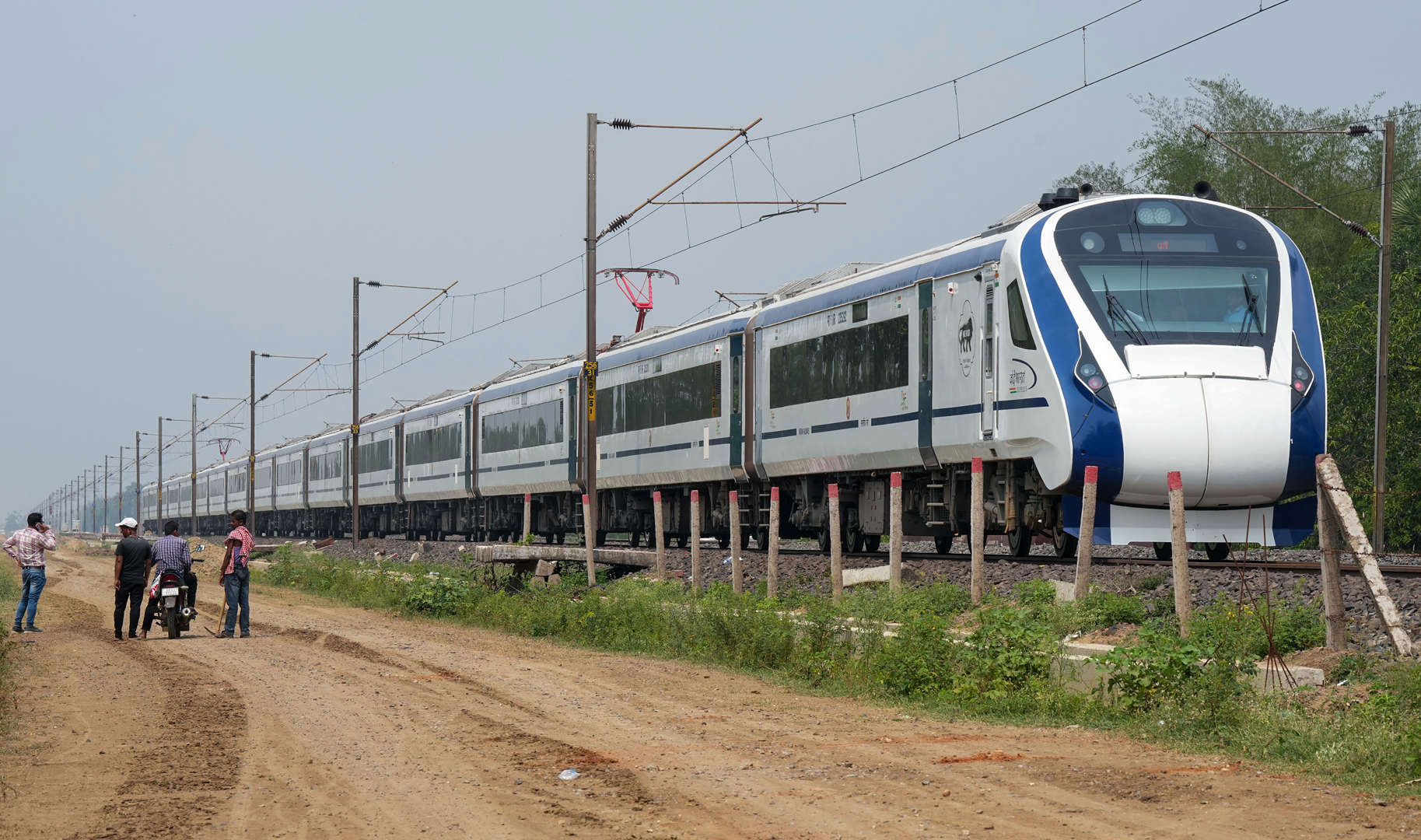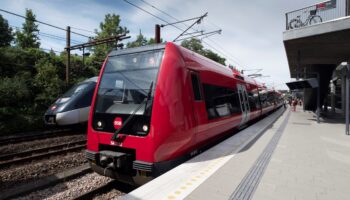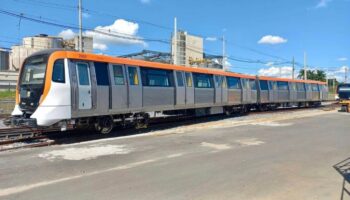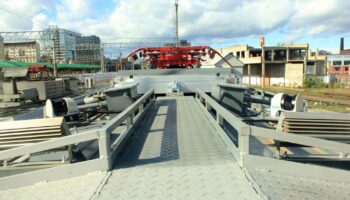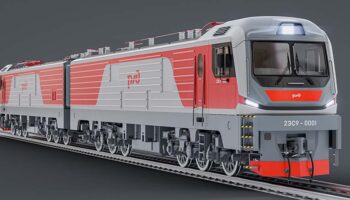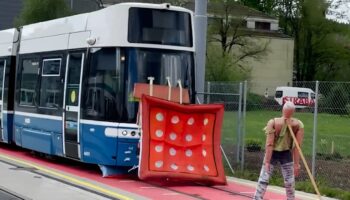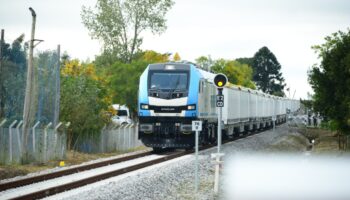A high level of transport accessibility is indispensable for India, the most populous country in the world. The total length of its railway network exceeds 68,000 km, making it the fourth largest in the world after the US, China, and Russia. The Indian government has identified rail transport as a growth area for passenger and freight mobility. It has been making record investments in renewing the rolling stock in recent years, and their volume will amount to $5.7 bln in the financial year from April 2023 to March 2024. India has chosen China as a benchmark in the development of the railway industry. Similarly, it relies on the creation and expansion of its own facilities and technology transfer with mandatory localisation under the national programme Make in India.
From Rolling Stock Market Trends almanac issued for the PRO//Motion.Expo 2023 International Railway Fair
Development of own train platform, Vande Bharat
A milestone project of Make in India widely covered by local media is the development of India’s first electric train with a maximum speed of 160 km/h. The vehicle under the working name Train 18 was designed by the Research Designs & Standards Organisation of the Indian Ministry of Railways. It was manufactured in just 18 months at the Chennai-based Integral Coach Factory (ICF) of the national operator Indian Railways (IR). Train 18 is based on the stainless steel body of Alstom’s LHB passenger cars localised in 2001. Imported components are also used: wheels, seats, doors, braking systems, transformers, and electrical components. The government set the task of developing a train half as cheap as imported ones, and the developers solved it. The new $14 mln train costs 40% less than similar vehicles of foreign manufacturers. Later Train 18 received a new name, Vande Bharat.
The first train was commissioned in February 2019. During the trials, it reached a speed of 183 km/h making it the fastest train in the country. However, the current state of the infrastructure does not allow Vande Bharat to be operated at this speed, so for now it does not exceed 130 km/h. But the distributed traction power system has enabled the train to achieve an acceleration of 0.8 m/s², so at 130 km/h Vande Bharat covers distances faster than the Rajdhani and Shatabdi locomotive-hauled long-distance express trains it is to replace.
The Vande Bharat 1.0 comprises four basic units of four cars, each unit consisting of a trailer car with or without a driver’s cab, two motor cars with traction converters, and another trailer car with a current collector, transformer, and converter. Two centre cars are first-class compartment cars with 52 seats, others are economy class with 78 seats (or 44 seats in head cars). Each train-set accommodates 1,128 passengers. All the cars have air conditioning systems.
Only two Vande Bharat 1.0 were produced between 2019 and 2022. In parallel, the second-generation train was developed and tested amidst the COVID-19 pandemic and disruption of global supply chains which obviously affected deadlines. Since the commissioning of the first Vande Bharat 2.0 at the end of September 2022, 25 such trains have started passenger service. According to IR, Vande Bharat 2.0 has improved acceleration and braking parameters. The train reaches a top speed of 160 km/h in just 129 s which is 11% faster than the first generation. Its designed residual acceleration is 0.11 m/s² compared to 0.05 m/s² of the first generation. Other improvements are a more efficient regeneration system, new air conditioning system, renewed interior, and smaller weight, 392 t compared to 430 of the first generation. The regenerative braking system can save up to 30% of electrical energy, and electrical equipment is protected against floods.
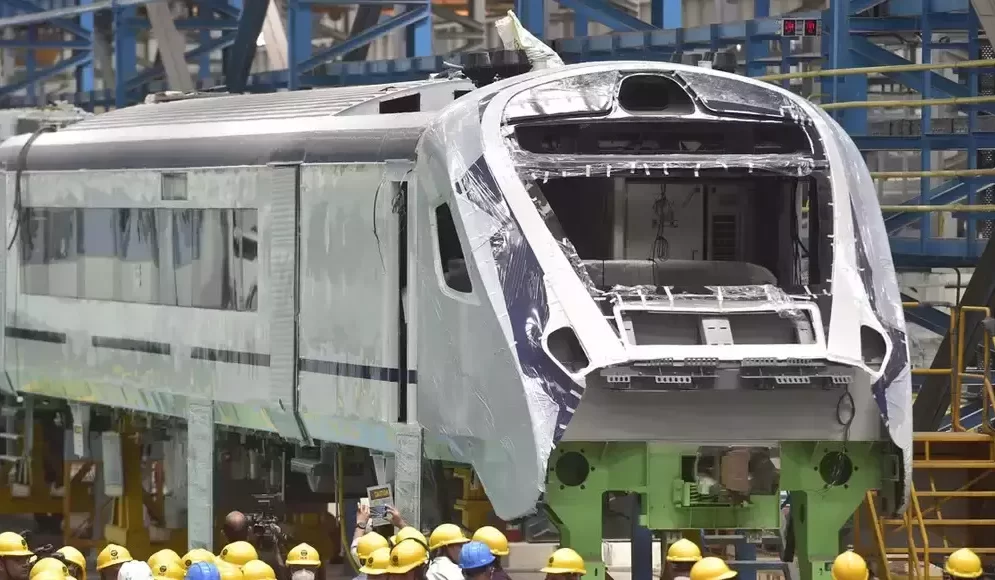 Manufacture of Vande Bharat 2.0 at Integral Coach Factory. Source: indiatimes.com
Manufacture of Vande Bharat 2.0 at Integral Coach Factory. Source: indiatimes.com
Vande Bharat is manufactured at ICF in Chennai only. Earlier, Indian Prime Minister Narendra Modi announced plans to commission 75 trains by 15 August this year, but only 25 of them were ready by the deadline. The expansion of production capacity which IR completed this May did not help. The new facilities allow for the production of only six or seven trains a month instead of four.
Later, the production of Vande Bharat will be launched at Marathwada Rail Coach Factory at Latur and Rail Coach Naveenikaran Karkhana at Sonipat. Their first orders will be for the manufacture of 400 Vande Bharat 3.0 and 4.0 under two tenders.
The first tender for 200 Vande Bharat 3.0 trains took place this spring. The larger lot for 120 trains (1,920 cars) was awarded to a consortium of TMH, Russia, and Rail Vikas Nigam Limited (RVNL), India. They offered the lowest price, $14.5 mln per train. Later TMH announced the delivery of the trains and 35-year maintenance can amount to $6.5 bln. The second lot for the delivery and maintenance of 80 electric trains (1,280 cars) for the same price was awarded to a consortium of local manufacturers Titagarh Wagons and BHEL.
The first two Vande Bharat 3.0 prototypes are expected for testing by the end of 2025. The delivery of the trains is scheduled for 2026–2030. TMH and RVNL will arrange the production and modernise facilities of a plant at Latur, and Titagarh Wagons and BHEL the one in Chennai. According to the tender documents, the Government of India will pay for the installation of new equipment at the sites and in workshops, while IR will provide power and water supply, access roads, and a catenary network at the sites.
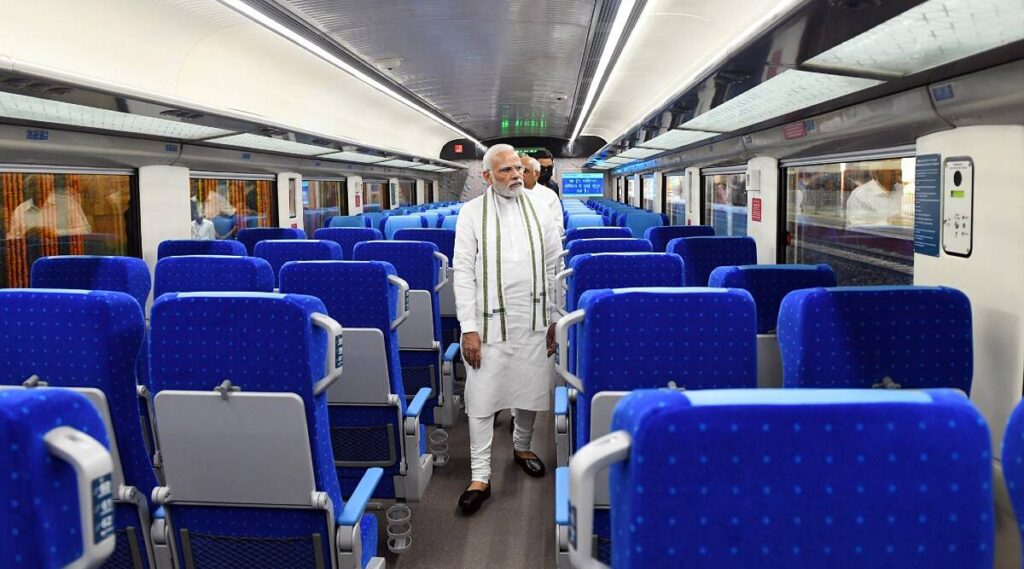 Prime Minister Narendra Modi examines the interior of Vande Bharat 2.0. Source: indianexpress.com
Prime Minister Narendra Modi examines the interior of Vande Bharat 2.0. Source: indianexpress.com
Lightweight bogies, transformers, and electric motors are stated to be developed for the third generation. The design speed of new trains with sleeping cars will remain the same, 160 km/h.
The second tender was floated to find a company to manufacture 200 Vande Bharat 4.0 trains at the plant at Sonipat. These trains too are expected to have one sleeping car and a body of lightweight aluminium alloy. The maximum speed of new trains will reach 200 km/h, and the country is now gearing up for such speeds. This May, Indian Minister of Railways Ashwini Vaishnaw said from 20,000 to 30,000 km of railways would be upgraded by 2027–2028 to allow trains to run at 160 km/h. The first lot for 100 4.0 trains was awarded to Alstom which offered the lowest price of a train, $18.2 mln. The cost of the contract including maintenance is expected to be $4.4 bln without taxes.
Two new train models are expected to be designed and manufactured by February–March next year. One of them, Vande Metro, will be a shorter version for lines between smaller cities with wider passages between seats so that one car could carry up to 250–300 people. This January, ICF received an order to produce a prototype of Vande Metro. The manufacture of the train is scheduled for 2024–2025. In June this year, Mumbai’s suburban operator MRVC announced a $5.4 bln tender for the supply of 238 twelve-car Vande Metro EMUs. The winner is expected to produce a prototype in two years and 50 trains each of the next five years.
The second model is a hydrogen train. In the current fiscal year, 35 such trains are planned to be procured each at a cost of about Rs 800 mln ($9.7 mln). The entire project including the infrastructure will cost Rs 52.5 bln ($635.4 mln) and will be implemented by Medha Servo Drives, a private company. Last spring it won an IR tender for the conversion of two diesel trains to hydrogen traction.
Alstom as a leader of urban rail transport in India
The country is not only developing regional rail transport. Rapid growth is visible in the urban rail transport systems sector. Several metro projects are underway that will increase mobility in large agglomerations. The main supplier of rolling stock, signalling systems, and components is a European manufacturer, Alstom. As of the beginning of this year, its backlog of Indian orders exceeded €4.7 bln.
Alstom has six production sites, four engineering centres, and more than 10,000 employees in the country. According to the company, the level of localisation of its products exceeds 80%. Alstom could have taken a large market share and expanded the scale of its presence in India thanks to the acquisition of Bombardier Transportation in January 2021. Under the terms of the deal, it received a rolling stock and bogie manufacturing facility in Savli, a traction unit plant in Maneja, an engineering centre in Hyderabad, and contracts awarded to the Canadian company. Now, Alstom fulfills several significant contracts. The first one worth $340 mln is for the supply of 30 suburban EMUs, and 10 metro trains for an urban line between Delhi and Meerut. The second contract worth €245 mln is for the supply of 67 Movia trains and signalling systems for the Agra and Kanpur Metros. The third contract is for the assembly of 31 metro trains for Mumbai.
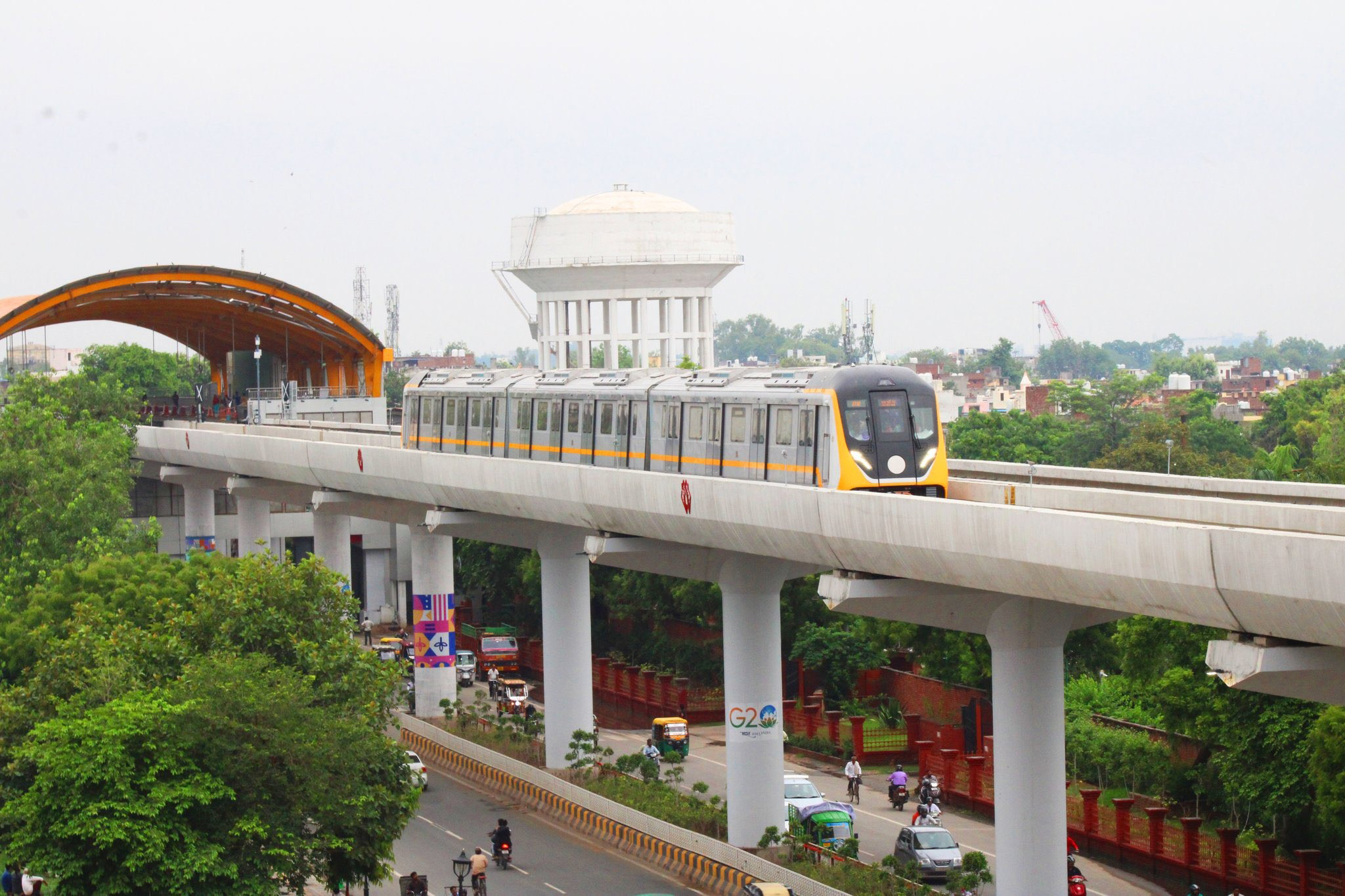 Test run of a metro train Astom Movia in Agra. Source: LucknowClicks/twitter
Test run of a metro train Astom Movia in Agra. Source: LucknowClicks/twitter
Alstom is not resting on previous success. The company is active in new tenders for the supply of rolling stock. In 2022 alone, Alstom won three major tenders totalling more than €800 mln. The July tender organised by state-owned Bhopal and Indore metro operator MPMRCL was for the supply of 156 Movia metro cars and signalling systems. Although the tender budget was €263.5 mln, Alstom offered €387 mln, and it was 30% lower than its competitor, BEML, India. In August, the company won a €98 mln tender for the supply of 26 unmanned Metropolis metro trains to Chennai. According to local media, Alstom again offered the lowest price against local BEML and Titagarh Wagons. The October tender was organised by Delhi Metro operator DMRC for the supply of 312 metro cars for €320 mln.
Alstom competes for new orders with local players, BEML and BHEL. These are large Indian state-owned manufacturers of a wide range of products with competencies in rolling stock production. Of the two, BEML has more experience: its trains run in five Indian metros. This year, the company offered the lowest price in a tender for the supply of 12 trains for the Bangalore Metro.
Titagarh Wagons has similar competencies but it’s a privately owned company. Since its inception in 2007, it has delivered more than 250 EMUs to IR, the highest among private rolling stock manufacturers in India. The company gained competence in urban rail vehicle manufacturing by acquiring Italy’s second-largest passenger rolling stock manufacturer Firema Trasporti in 2015. Now, the first three trains with aluminium bodies for the Pune metro are built at this plant under the contract for the delivery of 102 metro cars signed in 2019.
In July 2022, it was announced that local freight and passenger car manufacturer Jupiter Wagons planned to establish a metro car joint venture with CAF, but no further steps were taken.
Building high-speed railways
India is now building only one high-speed line and is preparing to build five more for travelling at speeds of more than 300 km/h with a total length of over 4,000 km.
The country’s first high-speed rail line, the Mumbai–Ahmedabad High Speed Rail Corridor, began construction in September 2017. The 1,435 mm gauge line of 510 km has 12 stations allowing a maximum speed of 320 km/h. The line put into operation, the journey from one endpoint to the other will be three times shorter, just two hours. The project has been postponed several times and according to the new schedule, the entire line is expected to be commissioned in 2029.
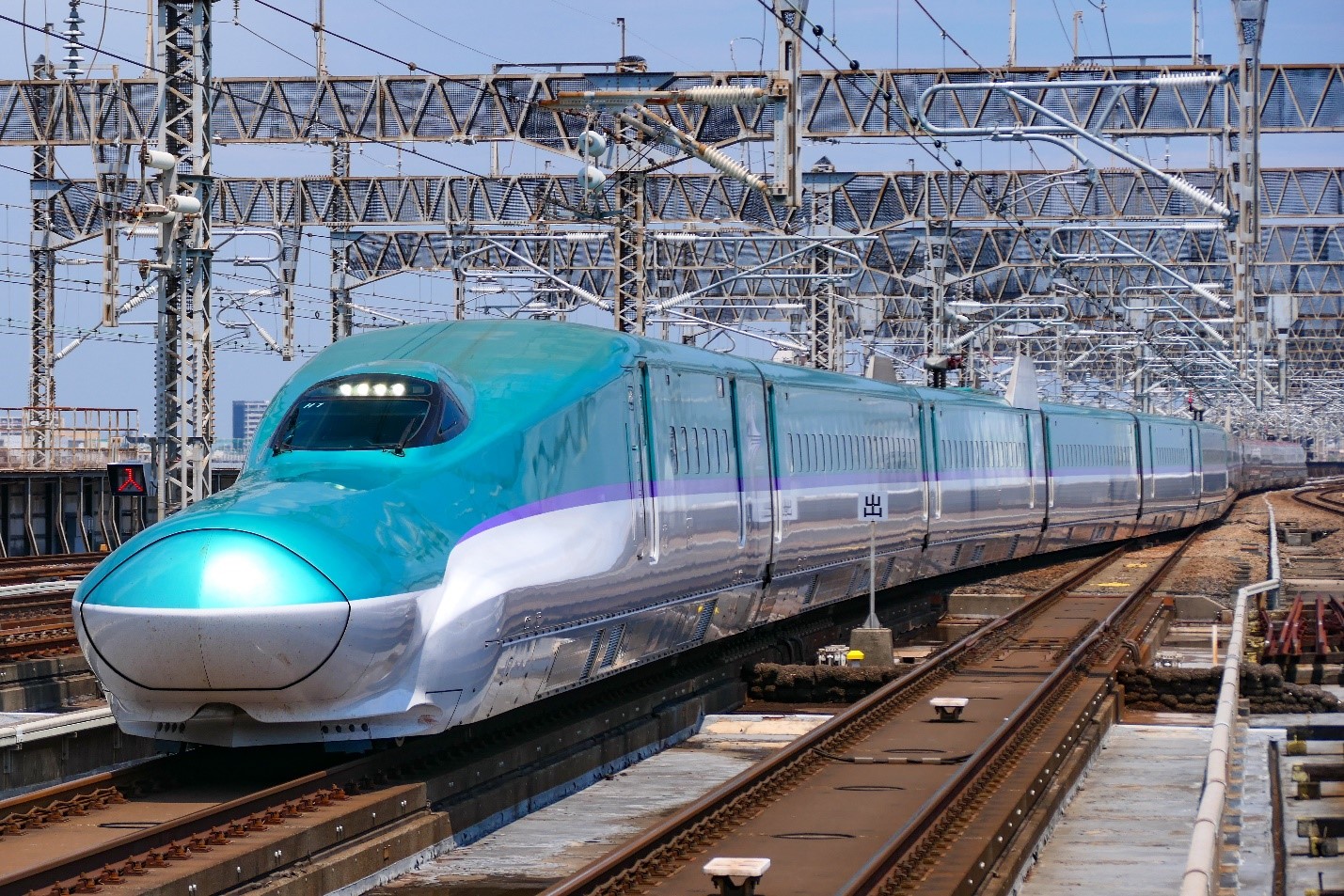 High-speed train E5 Shinkansen on the route to Tokyo. Source: MaedaAkihiko/wikimedia.org
High-speed train E5 Shinkansen on the route to Tokyo. Source: MaedaAkihiko/wikimedia.org
According to estimates, the total cost of the line will reach $20–25 bln. The Japanese International Cooperation Agency is responsible for about 80% of capital expenditure but dictates several conditions. India must purchase technical solutions in Japan, and only two Japanese manufacturers, Hitachi Rail and Kawasaki Rail, can participate in a tender for the supply of rolling stock. As local media report, India did not want to allow their joint bid which could lead to a higher price.
This July, the National High Speed Rail Corporation announced a tender for the supply of 24 E5 Shinkansen trains. Under the Make in India programme, six trains are to be assembled in India. They will comprise 10 to 16 cars and carry from 1,300 to 1,600 passengers. The price of one 10-car train cannot exceed $55.6 mln, and the project, $1.3 bln. Bids will be accepted until the end of October, and the first train is scheduled to be launched in 2027.
Shift to electric traction
The country has set an ambitious target of electrifying the entire broad gauge railway network by December 2023. As of 1 April, 58,400 km, or 90% of IR’s network were electrified. By 2030, 45% of cargo is expected to be transported by rail compared to the current share of 27%, and the speed of freight trains to increase from 22 km/h to 50 km/h.
In parallel, India is reducing the production of diesel locomotives, and some local plants have already completely switched to the manufacture of electric ones. Most of these are assembled at IR plants, CLW in Chittaranjan, BLW in Varanasi, and PLW in Patiala. In the financial year 2022–2023, these plants produced a total of 785 electric locomotives.
Two foreign-owned locomotive building plants operate in the country. The joint venture between Alstom and India’s Ministry of Railways is located in Madhepura. Since 2017, it has been producing 9MW electric freight locomotives class WAG-12B capable of hauling 6,000 t trains at a speed of 120 km/h. Under a 2015 contract with IR, the plant supplies 800 locomotives for €3.5 bln. This April, the 300th such electric locomotive was delivered, and the last one is due for delivery in 2028.
 Electric locomotive WAG-12B by Alstom and diesel locomotive WDG-4G by Wabtec. Source: unsplash.com
Electric locomotive WAG-12B by Alstom and diesel locomotive WDG-4G by Wabtec. Source: unsplash.com
In January, IR and Siemens Mobility signed a contract for the supply and maintenance of 1,200 mainline freight electric locomotives. The manufacturer will supply six-axle vehicles with a capacity of over 6.5 MW specified to haul loads of 4,500 t at an average speed of 75 km/h and modernise and expand IR’s assembly facilities in Dahod. According to plans, the first locomotive will be produced in early 2024 and the last one in 2034. Under the agreement, the export of 1,435 mm gauge electric locomotives manufactured in Dahod will be organised. Another tender has also been announced for the production of 800 electric locomotives with a capacity of more than 8.8 MW at the BLW plant under a public-private partnership.
Favouring electric traction today, IR continues to receive new diesel locomotives from the Marhowrah plant. Under the terms of a $2.5 bln contract signed in 2015, the joint venture between the operator and Wabtec is to deliver 300 4.4 MW WDG-6G diesel locomotives and 700 3.3 MW WDG-4G diesel locomotives over 10 years. This March, Wabtec announced the handover of the 500th locomotive.





